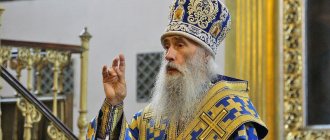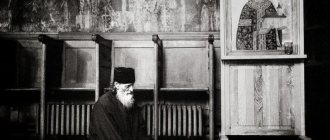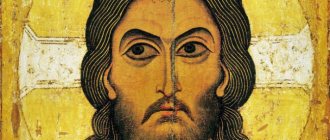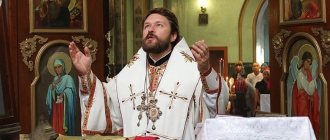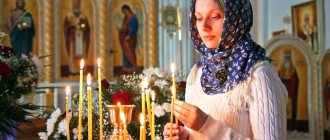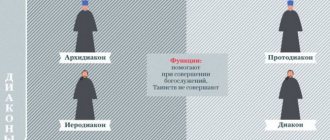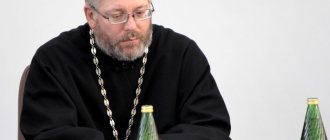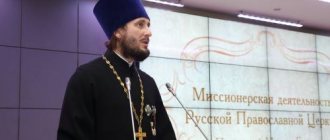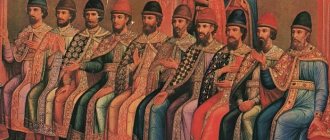Metropolitan Hilarion
Hilarion, whom the Tale of Bygone Years mentions as the founder of the Kiev-Pechersk monastery under the name of “presbyter Larion,” was installed as the Russian metropolis by the Kyiv prince Yaroslav the Wise no later than 1051. According to the same source, a council of all bishops of the Russian Church was convened to install Hilarion. He was the first Russian metropolitan of undoubted Russian origin. After 1054, that is, the death of Yaroslav the Wise, Hilarion is not mentioned in the metropolis.
Both the election of Hilarion and his removal from the see were, apparently, closely connected with relations with Byzantium at that time. Prince Yaroslav emphasized the independence of Rus' by independently electing a metropolitan. But after the death of Yaroslav, his son and successor Izyaslav normalized relations with Constantinople, returning to the previous procedure for installing the first hierarch.
Historians also connect Hilarion’s incident with the fact that initially the Russian Church may have been subordinate to Constantinople not directly, but through the Ohrid (Bulgarian) archdiocese. In the middle of the 11th century, the Byzantine emperors and patriarchs pursued a policy of Hellenization of the Bulgarian Church, which began to lose its Slavic character. This could also contribute to the alienation of the Russian Church from Constantinople and Ohrid. Finally, in 1054, the final split of Christianity into Catholicism and Orthodoxy occurred. Hilarion might not correspond to the new guidelines of the Church of Constantinople, and therefore he was removed from the pulpit.
Metropolitan Hilarion became famous for one of the first works of Russian literature - “The Sermon on Law and Grace.” It sets out the concept of Russian history, imbued with the idea of divine providence about Rus'. It is remarkable that Hilarion does not curse the pagan ancestors of Yaroslav the Wise, but, on the contrary, emphasizes their actions (especially Prince Svyatoslav) as great sovereigns who created a unified Russian state and thereby prepared Rus' to accept the light of the truth of Christ.
Information about him is scarce. It is only known that he was a Russian by birth, at one time he was a priest in the princely village of Berestovo, and early on he devoted himself to monastic exploits. Due to his education and ascetic life, Hilarion soon gained fame, the Grand Duke fell in love with him and, at the latter’s request, in 1051, a council of Russian bishops made Hilarion a Russian metropolitan. This was the first time that a metropolitan was installed from among natural Russians in Russia. The name of Hilarion is associated with the composition of the church charter (nomocanon) of Prince Yaroslav, which dates back to the last years of the reign of this prince. Apparently, Hilarion did not remain metropolitan for long: already under 1055 another metropolitan, Erem, is mentioned in the chronicles. The time of Hilarion's death is also unknown.Metropolitan Hilarion is one of the most famous writers of our elementary literature. From Hilarion’s writings we have reached us: “The Sermon on Law and Grace,” written even before Hilarion’s installation as metropolitan, “The Confession of Faith,” pronounced, it is assumed, on the occasion of the installation, “The Teaching on the benefits of the soul to all Christians” (attributed by some researchers to however, Hilarion the Great) and “A Word to a Brother Stylite”, found in a Serbian collection of the 14th - 15th centuries. The content of the first of these works is clear from its title: “On the law given by Moses concerning grace and truth that Jesus Christ was, and when the law departed, grace and truth filled the whole earth, and faith extended to all languages, and to our Russian language, and praise to our kagan Vladimir, from him we were baptized, and prayer to God from all our land.” The word is evidence of Byzantine education quickly penetrating Kievan Rus. The representative of this element, new in Rus', is not only the author himself, but also a whole circle of people to whom he addresses his “word” and whom he calls “abundantly filled with book sweets,” a circle of people who are “well-versed in books.” What is remarkable about the author is his enthusiasm; the entire first half of the word is like a continuous enthusiastic cry of an ancient Russian pagan who realized the poverty of the old faith in comparison with the new ideas and concepts brought by Christianity. What is extremely curious about the newly enlightened Christian metropolitan is the sense of national pride with which he recalls “old Igor” and “glorious Svyatoslav” - “not for the worse and not for the unknown of the land of your ruler,” the writer proudly declares, “but in “ The Russians know and hear the end of the earth.” The “Confession of Faith” is dogmatic in content and is distinguished by its theological accuracy and clarity of presentation. “Teaching on the benefits of the soul” and “Word to a brother-pillar” are brief and quite general in content. The literary activity of Metropolitan Hilarion was hardly exhausted by these works. “It is impossible to admit, one of the researchers rightly notes, that a person who has little practice in writing can suddenly write such an artistic word as Hilarion’s “Sermon on Law and Grace”, and express himself with such theological precision as his “Confession of Faith” is distinguished by.
Metropolitan Kliment Smolyatich
In 1130, the Greek Michael II was installed as Metropolitan of Kyiv and All Rus'. He was involved in the internecine struggle of the princes, caused general discontent and was forced at the end of 1145 to resign his rank and retire to Constantinople. Another reason for the metropolitan’s abdication was the church unrest in Byzantium itself.
Grand Duke Izyaslav II Mstislavich, who received the Kiev throne in 1146, took advantage of this situation to gain greater independence for the Russian metropolitanate from the patriarchate. Following the example of Yaroslav the Wise, in 1147 he convened a council of bishops, which elected as metropolitan Clement Smolyatich, a monk of the Zarubsky monastery, one of the most educated people of his time (according to the chronicler, “a scribe and philosopher, such as had never been seen in the Russian land”).
However, the opposition, led by Prince Yuri Vladimirovich (Dolgoruky), a contender for the Kiev throne, and the bishops of Novgorod and Smolensk - Nifont and Manuil, sharply opposed the election of Clement. They defended the need to observe canonical rules and install a metropolitan in Constantinople. Clement was kept in Kyiv only by the authority of Grand Duke Izyaslav, but after his death in 1154 he was forced to resign his rank. Yuri Dolgoruky, having taken the Kiev throne, accepted the Greek Constantine, appointed to the Russian metropolis.
Current situation
Kanonich. the territory of the Russian Orthodox Church covers the states that were part of the union republics of the USSR, with the exception of Georgia (together with Abkhazia and South Ossetia, it constitutes the canonical territory of the Georgian Orthodox Church; Orthodox parishes on the territory of Armenia belong to both the Russian Orthodox Church and the Georgian Church), as well as China and Japan. The dioceses and parishes of the Russian Orthodox Church are also located in the diaspora, that is, beyond the canonical. borders of autocephalous Orthodox churches in different countries on all continents of the world. In Russia, Ukraine, Belarus, Moldova, the Russian Orthodox Church is the largest religion. organization. The Russian Orthodox Church has two autonomous churches under its jurisdiction: the Japanese Autonomous Orthodox Church and the Chinese Autonomous Orthodox Church. The Russian Orthodox Church includes the self-governing Ukrainian Orthodox Church, the Orthodox Church of Moldova, the Latvian Orthodox Church and the Estonian Orthodox Church; The self-governing part of the Russian Orthodox Church is the Russian Orthodox Church Abroad (ROCOR). The jurisdiction of the Russian Orthodox Church includes the Belarusian Exarchate and 2 metropolitan districts - Kazakhstan and Central Asia.
The Russian Orthodox Church is the largest of the local churches in terms of the number of flocks (exceeding all of them combined). According to various estimates, depending on the choice of criterion for belonging to the Church, the number of the Russian Orthodox Church is from 100 to 200 million people.
A religious procession led by Patriarch Kirill from the city of Khotkovo to Sergiev Posad in honor of the 700th anniversary of St. Sergius of Radonezh. Photo. 16.7.2014. Press service of the Patriarch of Moscow and All Rus'
The order of governance of the Russian Orthodox Church is determined by its charter, adopted by the Bishops' Council in 2013. According to the charter, the highest bodies of church power and administration are the local council and the bishops' council, as well as the Holy Synod headed by the patriarch. The Primate of the Russian Orthodox Church is Patriarch Kirill (Gundyaev) of Moscow and All Rus' (elected January 27, 2009, enthroned February 1, 2009). Execute church governance body - the Supreme Church Council, which unites the heads of synodal institutions under the chairmanship of the patriarch. Consult. The body is the Inter-Council Presence, a permanent expert community that develops documents of general church significance. Judicial powers are exercised by the General Church Court, as well as diocesan courts. Dept. Synodal departments and commissions, as well as patriarchal commissions and councils, are in charge of areas of church affairs. Particular attention is paid to missionary and educational. activities, social service. Since 2011, a major reorganization of the structure of the Russian Orthodox Church has been carried out, associated with the disaggregation of dioceses and the introduction of a two-stage structure on the territory of the Russian Federation: dioceses are part of metropolitanates, the boundaries of which coincide with the boundaries of the previous dioceses before their disaggregation. The Russian Orthodox Church has 52 metropolises, 286 dioceses, 35,496 parishes, 888 monasteries (2015). The system of theological education of the Russian Orthodox Church includes 5 theological academies, 52 theological seminaries, 37 theological schools, as well as 3 Orthodox universities and 2 theological institutes (2015).
Moscow Saints Peter and Alexy
Metropolitan Peter, the first head of the Russian Church to choose Moscow as his residence, was born in Volyn. In 1305, being the abbot of the monastery he founded on the Rata River, he was installed by the Patriarch of Constantinople as Metropolitan of Kyiv and All Rus'. Peter's predecessor, Metropolitan Maxim, already lived in Vladimir-Zalessky. Peter provided patronage to the policies of the Moscow Grand Duke Ivan Kalita, for which the latter contributed to his canonization already in 1339 (he died in 1326).
After the leadership of the Russian Church by the Greek Theognostus (1328-1353), Alexy (in the world Feodor Byakont), a boyar's son, was installed as metropolitan. The further rise of Moscow is associated with his activities. Peter and Alexy are considered the heavenly patrons of the capital of Russia.
Mityai, Dionysius and Gerasim
The last years of Alexy's life and the first years after his death were darkened by church unrest. In 1376, Patriarch Philotheus appointed Serbian Cyprian Metropolitan of Kyiv and All Rus'. But Grand Duke Dmitry Ivanovich (the future Donskoy) declared that he would not accept the new metropolitan while Alexy was alive. Two years later he died. However, the Grand Duke wanted his own protege for the metropolitanate, fearing that Cyprian would not become as zealous a proponent of pro-Moscow politics as Alexy.
Dmitry nominated Mityai, whom he had recently appointed archimandrite of the Spassky Monastery, bypassing all degrees of monasticism. Mityai was sent to Constantinople for installation, but died on the way, and the ambassadors of the Grand Duke arbitrarily decided to submit the candidacy of Archimandrite Pimen, a Greek by birth, for approval by the patriarch.
In 1383-1385. The metropolitan see was occupied by Dionysius, originally from near Kyiv, and in 1433-1435. - Gerasim, a Muscovite. Both were assigned to Constantinople.
Chapter 1. System of governance in the Russian Orthodox Church (1700–1917)
The entire territory of Russia was divided into dioceses (church districts). At the beginning of the 18th century. There were 21 dioceses in the Russian Church. The former patriarchal region occupied a special position. In 1742 it was divided into Moscow and St. Petersburg dioceses. In 1744, 4 more dioceses were established. In 1764 there were 29 dioceses within Russia and one Mogilev in Poland, in 1799 - 36, and by the end of the reign of Alexander I there were already 40 dioceses. During the reign of Nicholas I, 13 new dioceses were formed. Under Alexander II and Alexander III, 10 more dioceses were opened (including Finland, Aleutian and Alaskan). In 1917, the Russian Church numbered 68 dioceses. On average, there were about a thousand church parishes per diocese.
In 1788, Catherine II made an attempt to bring the boundaries of the dioceses to the provincial ones, but such territorial coincidence was practically achieved only under Nicholas I.
In 1764, the dioceses (of which there were then 29) were divided into three classes: metropolitanates (3), archbishoprics (8) and bishoprics (18). In 1867, this division was abolished. And before that, the salary and maintenance of the bishop’s house, and sometimes the rank of diocesan bishop, depended on the class of the diocese.
Only a representative of the black clergy could become a diocesan bishop, and mainly from among the “learned monastics” (graduates of theological academies). The diocesan bishop was regarded as "the rector and chief teacher of the faith in his diocese." He ordained clergy (priests and deacons) in his diocese, appointed clergymen (clergymen) to positions, punished them for various omissions and misconduct - up to and including dismissal from office (deprivation of ordination was the prerogative of the Synod, conviction for a crime - of the secular criminal court).
Let us present data on the number of higher (diocesan) clergy for the years 1841–1891 (see Table 1).
Table 1
The number of higher clergy in Russia in 1841-I891.
| Years | metropolitans | archbishops | bishops | Total | incl. diocesan | Vicars | "at rest" |
| 1841 | 4 | 28 | 38 | 70 | 47 | 11 | 12 |
| 1851 | 3 | 26 | 38 | 67 | 52 | 11 | 5 |
| 1861 | 4 | 29 | 53 | 86 | 57 | 13 | 16 |
| 1871 | 3 | 20 | 63 | 86 | 57 | 28 | 1 |
| 1881 | 3 | 17 | 66 | 86 | 57 | 29 | – |
| 1891 | 3 | 12 | 88 | 103 | 62 | 38 | 3 |
Source: Preobrazhensky I.G. The Russian Church according to statistical data from 1840/41 to 1890/91. – St. Petersburg, 1897, p. 12.
During consecration (ordination), the bishop swore an oath to observe church traditions, holy canons, protect church peace, govern the flock in the spirit of evangelical meekness and show obedience to the highest church authorities, not to anathematize or excommunicate anyone for personal reasons, to deal with those who have fallen away peaceful, meek and prudent. He was required to keep the monks of his diocese “in all the strictness of monastic regulations”, not to build churches “unnecessarily” and not to appoint clergymen “beyond the need”, dead bodies, without a church examination, not to pass off as holy relics; punish those pretending to be violent with spiritual measures and hand them over to secular authorities, do not allow “fictitious miracles” from icons and sources, and do not interfere in worldly affairs.
Within his diocese, the bishop had administrative, judicial and economic power over the clergy entrusted to him. He was responsible for the state of faith and morality, supervised the preaching and liturgical activities of the clergy, supervised the entrusted institutions and headed the spiritual court. In relation to the Holy Synod, he had the right to make legislative and administrative proposals. He represented the interests of the Church before local government authorities, with whom he often had friction due to its interference in the affairs of his diocese.
During the synodal period, the prerogatives of diocesan bishops were significantly limited due to the centralization of church administration and the strengthening of the power of the Holy Synod. As noted by the famous historian of the synodal period of the Russian Orthodox Church I.K. Smolich, “the power of bishops, almost absolute in the 17th century, during the synodal period underwent certain restrictions within the framework of state churchism. The Holy Synod increasingly intervened in the affairs of diocesan administration; The chief prosecutors sought to make consistories branches of their apparatus to the detriment of the power of the bishop, and the state considered the clergy as its subjects, thereby limiting the scope of church laws."7
The spiritual regulations ordered the bishop to travel around his diocese at least once a year and regularly submit to the Synod both annual reports on the state of the diocese and reports on particularly important and urgent matters.
The diocesan bishop, as the main teacher of the faith, was entrusted with supervision of all theological schools in the diocese, as well as control over the teaching of the Law of God in secular schools. Parochial schools were also subordinate to him. Questions about opening new parishes or closing old ones; Bishops could establish and close monasteries and theological schools only with the permission of the Synod, making appropriate representations to it about this.
The bishops could exercise power in relation to their subordinates, but in the face of the synodal leadership they felt powerless. For a long time, bishops recalled the times of “conciliar” orders in the church (before the introduction of centralized synodal governance). “And before, under the council’s rule,” said Professor Sergius Stragorodsky (the future patriarch) in the Council of the St. Petersburg Theological Academy in 1901, “no matter how rarely any bishop attended the Councils, he was still considered an indispensable member of the Council, had the right to vote, could send his deputy, could present his opinion, etc. The central government, while remaining, of course, power, was not an external authority for him, because he considered himself involved in this authority. The Synod directly established itself as an unconditional, almost peremptory authority over every representative of the Russian hierarchy. The diocesan bishop can be in the Synod only when he is called. Sometimes they may ask him for his opinion, they may send him some complicated case for review... Participation in power, the right to this participation is no longer even a question. The central government, thus, separated from the diocesan into a completely special body, acting peremptorily according to the sovereign's decree. As we see, a radical change has occurred; one might say, the very spirit of the church government has changed.”8
Under the diocesan bishop there was a consistory - a diocesan administration consisting of four to six clergy and civil officials. At the beginning of the synodal period, consistories were called differently: spiritual orders, spiritual boards, dicasteries. By decree of July 9, 1744, it was decided to call them spiritual consistories. According to the Charter of Spiritual Consistories of March 27, 18419, revised in 1883, consistories were considered as public places through which bishops governed their diocese and administered spiritual court in it. Consistories consisted of 5–7 members elected from among the archimandrites, abbots, and in the 19th century. besides them, there were also representatives of the white clergy - archpriests and priests. The composition of the consistory was approved by the Synod on the proposal of the diocesan bishop. They left in the same order. To handle cases, the consistory had a special office, which was headed by a secular official-secretary, who was appointed and dismissed by the chief prosecutor of the Synod. He was subordinate to both the diocesan bishop and the chief prosecutor of the Synod. The consistory was in charge of the appointment and removal of parish clergy and clergy, brought them to the church court for offenses in office, supervising the conduct of the church economy in the diocese, the construction and improvement of churches, carried out the orders of the Synod, and compiled reports and reports on the diocese for it. According to the Charter of spiritual consistories on March 27, 1841, the main person of the consistory was its secretary. Although he was appointed by the Synod, he was subordinate not to the Synod, but directly to the chief prosecutor, to whom he reported in everything. Thus, the consistory found itself in dual subordination - to the diocesan bishop (as the head of the diocese) and the chief prosecutor of the Synod. “Thus,” as I.K. rightly noted. Smolich, the chief prosecutors had a strong and independent support in the diocesan departments”10. In addition to the consistory, for the management of minor current affairs, the bishop had a diocesan office - similar to the office of the chief prosecutor of the Synod11.
The Charter of Ecclesiastical Consistories of 1841 clearly defined the place and prerogatives of the consistory. Under the direct supervision of the diocesan bishop, she carried out administrative and judicial functions. The highest authority for the consistory was the Synod. The consistory consisted of a presence (whose members were appointed by the bishop from white and black clergy, approved and, if necessary, dismissed by the Synod) and an office. Each member of the chancellery was entrusted with a special range of tasks. But decisions on all cases were made at joint meetings. The office of the consistory was under the leadership of a secretary who was appointed by the Synod at the suggestion of the chief prosecutor. According to the Charter of 1841, the administrative tasks of the consistory were defined as follows: 1) appointment to church positions, 2) reports and characteristics of candidates for positions, 3) tonsure in the monasteries of the diocese, 4) management of the bishop's house (its property), as well as management of monasteries and temples. It is important to note that the jurisdiction of consistories extended not only to the clergy, but also to the laity of a given diocese. Thus, they could bring the laity to church court, with the exception of crimes that, according to the Code of Laws, were subject to civil court. The consistory could bring in the clergy for misconduct in the service, as well as against “good behavior and decorum.” The consistories were in charge of church property and the analysis of cases related to complaints from both the clergy and laity against clergy. Decisions were made collectively and submitted for approval to the bishop, who could send it for reconsideration to the consistory. If opinions were divided, the final decision was made by the bishop.
In the 18th century (more precisely, in the first years of the synodal period) in the dioceses, to test candidates for church positions, there were learned monks who conducted exams for them. They also served as secretaries to the bishop. And before the secularization of monastic property, the bishop had economists with a staff to manage the monastic estates.
In the 60s, dioceses began to publish “Diocesan Gazette” with appendices. In addition to official information, “Diocesan Gazette” also published “unofficial” information - on the history of local churches and monasteries, about personalities, historical and ethnographic materials, and memoirs of clergy.
Rejection of the Union of Florence
The final confirmation of Russian hierarchs on the metropolitan throne is associated with the rejection by the Russian Church of the Florentine Union with Rome. In 1437, a new metropolitan, the Greek Isidore, arrived in Moscow. This was the time when Constantinople, perishing under the blows of the Ottoman Turks, was looking for external help and for its sake was even ready to recognize the dogmas and supreme power of the Vatican. To unite the churches, Pope Eugene IV convened an Ecumenical Council in Ferrara, which later moved to Florence (1438-1439).
At this council, all hierarchs of the Orthodox Church of Constantinople accepted the dogmas of Catholicism. Returning to Moscow in 1441, Isidore shocked everyone by first of all remembering the Pope at the service, and also read a message about church union with Rome. Grand Duke Vasily II immediately opposed the unheard-of innovations and ordered the metropolitan, who had betrayed Orthodoxy, to be taken into custody and subsequently expelled. Until 1458, Isidore called himself “Metropolitan of Kyiv and All Rus'.”
In 1448, the Council of Bishops of North-Eastern Rus' elected the Ryazan priest Jonah “Metropolitan of All Rus'” with his seat in Moscow. Since that time, the Russian Church has been steadily and permanently divided into two metropolises: Eastern and Western Russian (before that these were only episodes). The Metropolitan of Moscow ceases to serve in Constantinople, even after the latter (after the Ottoman conquest) rejects the union and becomes Orthodox again. Since that time, the Russian Church has been led by Russians.

